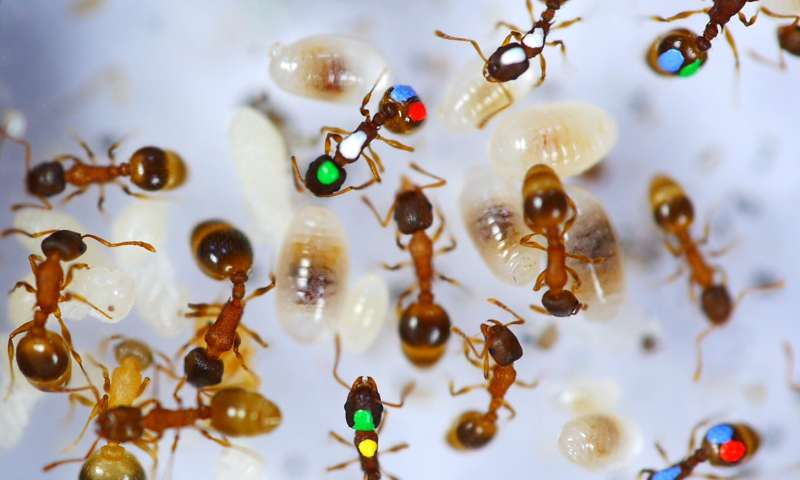via the Guardian by Jonny Weeks

During its 20-year mission to Saturn, Nasa’s Cassini spacecraft has captured some breathtaking images of the ringed planet and its moons, revealing many unexpected secrets. Here are some of the best
==============================
via Boing Boing by Cory Doctorow

Ants are cultural signifiers of busy industriousness, but a new paper in Plos One reveals that, across species, about 40% of “worker” ants spend most of their days doing nothing.
The researchers hypothesize that the "lazy" ants form both a reservoir of genetic material and a reserve workforce that serves as a hedge against the death of the “productive” ants. They may also serve as an emergency food supply for hard, cannibalistic times.
Continue reading
==============================
via 3 Quarks Daily: Ban Panko in Smithsonian
:focal(2289x1071:2290x1072)/https://public-media.smithsonianmag.com/filer/d8/93/d893d8c9-1513-4528-8fec-40d761a49636/b3day1.jpg)
With their small furry bodies and large inquisitive eyes, gray mouse lemurs can seem like a cross between a pug and an alien. In fact, these Madagascar primates share much in common with us. For one, they feel mounting stress as their forest habitat is destroyed—and new research shows how living under constant pressure can hurt their survival. Mouse lemurs are a subgroup of lemurs that boast the title of smallest primates on Earth. The gray mouse lemur (Microcebus murinus), which measures in at just under a foot from nose to tail and weighs around two ounces, is the largest species within that group. It's currently considered to be a species of “Least Concern” by the International Union for Conservation of Nature's “Red List,” but the organization does note that the population of gray mouse lemurs is declining due largely to habitat loss.
Continue reading
==============================
via OUP blog by Elias Sacks

Gotthold Ephraim Lessing and Johann Kaspar Lavater as guests in the home of Moses Mendelssohn by Moritz Daniel Oppenhiem (1800-1882) Judah L. Magnes Museum. Public Domain via Wikimedia Commons.
How tolerant and diverse should a society be? Are there limits to the views that a society should accept? Can individuals from diverse backgrounds join together to contribute to the common good, and what happens when tensions arise between different groups? To what extent should individuals be asked to adapt to a putatively shared national culture, and should they be encouraged to preserve their own distinctive cultural inheritances?
Continue reading
==============================
via Big Think by Philip Perry

Planet OGLE-2005-BLG-390Lb discovered in 2006. Getty Images.
“Diamond Rain” might sound like a newly discovered Prince track. In actuality, it’s a phenomenon scientists believe is occurring on at least two of our solar system’s planets. Neptune and Uranus have hydrocarbon-filled atmospheres, which suggest this weird phenomenon. These are dangerous, greenhouse gases. Sure, it seems more like one of Scrooge McDuck’s daydreams than scientific reality. Even so, a study published in Nature Astronomy, proves it’s possible.
Continue reading
==============================
via Interesting Literature
The meaning of a curious fairy story
‘Sleeping Beauty’ is, depending on which version of the story you read, called Sleeping Beauty, Talia, Little Briar Rose, Rosamond, or Aurora. This is because, like many other classic fairy tales, the tale of Sleeping Beauty exists in numerous versions, each of which is subtly – or, in some cases, quite strikingly – different from the others. In the Italian version published in the Pentamerone, an Italian collection of fairy tales published in 1634, the heroine is named Talia. Charles Perrault, in his version published later in the century, calls her the Sleeping Beauty. The Brothers Grimm call her Dornröschen or ‘Little Briar Rose’, which is sometimes adapted as ‘Rosamond’. In the Disney film, the adult heroine is named Aurora. For the purposes of clarity here, we’re going to call her ‘Sleeping Beauty’ or ‘the princess’.
Continue reading
==============================
via The Guardian Weekly

From Billy and the Minpins. © Quentin Blake 2017
Read all about it here
==============================
via ResearchBuzz: Firehose
“Tonight, when you pick up your book, observe the legacy of sewn gatherings in the fixings of the pages. Discern, in your fountain pen, the memory of the hollow feather. What follows is a general, Wiki-How-style overview of how a medieval manuscript would have been fashioned. The craft flourished for over 1,000 years and dominates the material foundation of Western literary culture.”
Reading this made me really appreciate the artists and crafters who made these books. Tara
I probably would not get past the “first slaughter your animal and skin it”. Hazel
Read it for yourself
==============================
via AbeBooks.com – an interview with Sandra Hindman
Sandra Hindman is a leading expert on Medieval and Renaissance manuscript illumination. Professor Emerita of Art History at Northwestern University and owner of Les Enluminures, Sandra is author, co-author, or editor of more than 10 books, as well as numerous articles on history, illuminated manuscripts and medieval rings. AbeBooks posed a number of basic questions about medieval manuscripts and Sandra was kind enough to answer them.

An illuminated psalter (a book contained psalms) manuscript on parchment from Southern Germany circa 1240-1260 offered by Les Enluminures for £134,650
Continue reading
==============================
via Boing Boing by Mark Frauenfelder

Here’s a great collection of 1950s and 1960s Eastern European matchbook covers, many with a space exploration theme.
I don’t understand a word but the graphic design is definitely of my era.
No comments:
Post a Comment